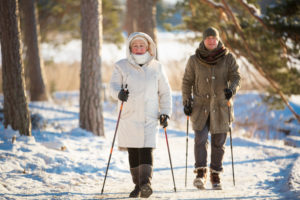 With temperatures dropping and fewer hours of daylight many of us cut down on our exercise at this time of year. Although it seems natural to want to avoid the cold temperatures, there are some great benefits to bundling up and heading outdoors for your workout this winter.
With temperatures dropping and fewer hours of daylight many of us cut down on our exercise at this time of year. Although it seems natural to want to avoid the cold temperatures, there are some great benefits to bundling up and heading outdoors for your workout this winter.
- It may be cold, but you can still feel the burn. According to research in The Journal of Clinical Endocrinology & Metabolism, regular exercise in cold temperatures can increase the production of calorie-burning brown adipose tissue, also known as brown fat (Brown fat one of the two types of fat that humans and other mammals have. Its main function is to turn food into body heat. It is sometimes called “good” fat), by 45 percent as well as increase your overall metabolism. This is extremely helpful if you’re trying to avoid that pesky winter weight gain.
- Get outside and get happy. We know that exercise has the ability to improve our mood and reduce stress and anxiety. But exercising outdoors may have added benefits. A 2017 study compared two exercise groups; one went hiking outdoors for several hours while the other group walked on a treadmill indoors. When the two groups were compared, the group that exercised outdoors showed more improved feelings of pleasure and reduced feelings of fatigue than the indoor group.
- Get your daily dose of Vitamin D. Exercise is essential to overall good health, but outdoor exercise may be even better. Most of us have reduced levels of vitamin D in the winter because we aren’t out in the sun as much. According to a study from the National Health and Nutrition Examination Survey, outdoor exercise may be associated with decreased risk of dying from cardiovascular disease by up to 27 percent over being sedentary. This correlation was strongly associated with higher levels of vitamin D, which supports bone health, immune function and may protect against cancer, diabetes and heart disease.
- Fresh air does the body good. It’s a myth that cold air can make you sick. It may be called the common cold, but the colder temperatures alone aren’t what make you sick. In fact, it’s the opposite. According to the National Institute of Allergy and Infectious Diseases, cold viruses grow best at about 91 degrees. The cells in your body that fight infection actually increase if you go out into the cold. It’s the body’s way of combating the stress of freezing temperatures.
The benefits out outdoor exercise usually outweigh the risks for most people; however there are some important factors to take into consideration before heading out the door.
- What does your heart say? If you have a history of heart disease or risk factors for heart disease such as high blood pressure, high cholesterol, diabetes or you’re a smoker, among other risk factors, cold-weather exercise may actually cause a heart attack. Make sure you check with your doctor before starting any fitness regimen, whether it is regular indoor exercise or outdoor exercise.
- Don’t forget your H2O. We all know that drinking enough water every day and staying hydrated is essential to our health. But when you exercise outdoors in the cold, you may not think you’re sweating as much. It’s important to remember that you’re still losing body fluid and research indicates that your thirst response may be diminished in colder temperatures. Remember to drink before, if possible during, and after outdoor exercise to prevent dehydration.
- Take care of your skin. You can still get sunburn in the winter even though it might not be as sunny, or may even seem cloudy. The Earth’s surface is actually closer to the sun during the winter months so we are exposed to more harmful rays without even realizing it. Additionally, snow and ice can both reflect up to 80 percent of harmful UV rays. Protect your skin all year round. Put on sunscreen before going outside and moisturize before and after outdoor exercise to prevent your skin from getting dried out and irritated from cold winds.
- Dress for the occasion. It’s important to not over- or underdress for outdoor exercise. When you workout, your body tends to heat up pretty quickly so if you bundle up too much you can overheat and sweat more which will make you feel colder when you slow down or stop. It’s best to dress in layers that you can take on and off easily. The layer closest to your skin should have sweat wicking properties to keep you as dry as possible.
“Another important factor to consider when dressing for winter workouts is footwear,” said Timothy Lee PT, DPT, of Mather Hospital’s Department of Physical Therapy. “Choose appropriate shoes for the occasion, whether they be sneakers, snow boots or hiking boots. Typically, a larger tread, or soles with deep lugs are patterned for extra grip on slippery surfaces. Shoes with non-slip soles will reduce your chances of slipping on snow. However, if icy conditions are expected, the benefit of outdoor exercise is outweighed by the dramatically increased risk of falls during inclement conditions. In that case, I would substitute with indoor exercise,” Lee said.
Try doing some warmup exercises like stretching or jumping jacks before heading outside to make the transition to the colder temperatures a bit more bearable. If you really hate the cold, don’t sweat it! Or, just continue to sweat it indoors. Move your exercise routines inside to the comfort of our own home or the local gym – as long as you keep moving!

